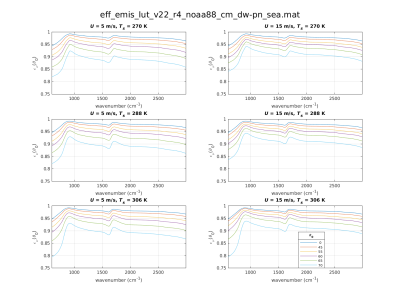Remote Sensing

研究区域为 大红山铁矿,位于中国云南省玉溪市。 矿区海拔600米-1850米,属于侵蚀 和剥蚀山地地形,深切口,大起伏和 沟壑和山谷网络。矿井主体为裸露岩石 周围植被覆盖。主要岩性是变质熔岩, 辉长岩、辉长岩和白云石方钠石。
- Categories:
 19 Views
19 ViewsThe dataset includes channel frequency response (CFR) data collected through an IEEE 802.11ax device for human activity recognition. This is the first dataset for Wi-Fi sensing with the IEEE 802.11ax standard which is the most updated Wi-Fi version available in commercial devices. The dataset has been collected within a single environment considering a single person as the purpose of the study was to evaluate the impact of communication parameters on the performance of sensing algorithms.
- Categories:
 3252 Views
3252 ViewsThermal infrared (IR) environmental satellite data assimilation and remote sensing of the surface and lower troposphere depend on accurate specification of the spectral surface emissivity within clear-sky forward calculations. Over ocean surfaces, accurate modeling of surface-leaving radiances over the sensor scanning swaths is complicated by a quasi-specular bidirectional reflectance distribution function (BRDF).
- Categories:
 200 Views
200 Views
Detection of impact craters on the surface of Mars is a critical component in the study of Martian geomorphology and the evolution of the planet. As one of the most distinguishable geomorphic units on the Martian surface, accurate determination of the boundaries of impact craters provides valuable information in mapping and research efforts. The topography on Mars is more complex than that of the moon, making detection of real impact crater boundaries a challenging task.
- Categories:
 24 Views
24 Views
We propose an algorithm based on linear prediction that can perform both the lossless and near-lossless compression of RF signals. The proposed algorithm is coupled with two signal detection methods to determine the presence of relevant signals and apply varying levels of loss as needed. The first method uses spectrum sensing techniques, while the second one takes advantage of the error computed in each iteration of the Levinson-Durbin algorithm. These algorithms have been integrated as a new pre-processing stage into FAPEC, a data compressor first designed for space missions.
- Categories:
 570 Views
570 ViewsSynthetic Aperture Radar (SAR) satellite images are used increasingly more for Earth observation. While SAR images are useable in most conditions, they occasionally experience image degradation due to interfering signals from external radars, called Radio Frequency Interference (RFI). RFI affected images are often discarded in further analysis or pre-processed to remove the RFI.
- Categories:
 330 Views
330 Views
As a common dataset for change detection, its image can be divided into three parts: the image before the change, the image after the change, and the label image showing the changed area. This dataset is characterized by significant seasonal differences between bi-temporal image pairs, which makes up for some of the deficiencies in existing datasets. The labels for this dataset include some irregular changes, such as the appearance and disappearance of cars; but do not include seasonal changes, such as changes in the ground surface caused by snowfall.
- Categories:
 1024 Views
1024 Views
Accurate detection and segmentation of apple trees are crucial in high throughput phenotyping, further guiding apple trees yield or quality management. A LiDAR and a camera were attached to the UAV to acquire RGB information and coordinate information of a whole orchard. The information was integrated by simultaneous localization and mapping network to form a dataset of RGB-colored point clouds. The dataset can be used for methods related to apple detection and segmentation based on point clouds.
- Categories:
 782 Views
782 Views



